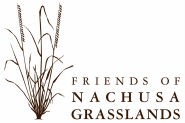The Restoration Process
Since 1986, Nachusa crew members and volunteers have been reconnecting remnant prairie, woodlands, and wetlands through habitat restoration to create one of the largest and most biologically diverse grasslands in Illinois. Most new Nachusa plantings transform agricultural fields to prairie, although several projects involve restoring degraded savannas, woodlands, and wetlands.
Grassland restorations require research and planning; seed collection; site preparation; planting; and management.
|
Research and Planning: Ascertaining the soil types, hydrology, topography, and sun exposure of the target area helps determine the types of species that will flourish in the planting. Restoration plan example: West Holland Savanna Restoration Plan
Seed Harvest: Seed collection at Nachusa Grasslands usually begins in May and ends in November. Deciding if a particular species is ready for harvest is a complex task, so the stewards and staff confer frequently on when and where to collect seeds. We harvest over 200 native species, mostly by hand using scissors or snips, and then dry, mill, and store them in preparation for planting. Fire and Additional Site Preparation: If a cornfield is being restored to prairie, the stalks are often mowed after the harvest is complete. Then the site is burned to remove the rest of the stubble. If appropriate, drainage tiles are removed and scrapes are bulldozed to create wetlands. Sometimes, the soil is also disced or harrowed to give the seeds good contact with the ground and a better chance to germinate. |
Planting: Sowing is usually done in the late fall or early winter after the seeds have been mixed according to the soil conditions of the site. For mechanical planting, we pull pendulum and drop spreaders behind tractors, trucks, or UTVs. The seeds are poured into a hopper, which evenly distributes them over the field. Hand planting involves tossing, raking, or stepping in seeds, depending on the area being restored and the types of seeds. Often, overseeding of restorations takes place for several years after the initial planting in order to fill in gaps and increase species diversity.
Weed and Brush Management: Native plantings are usually very weedy during the first few growing seasons. Although some agricultural weeds will diminish on their own, many invasive species, such as sweet clover, reed canary grass, red clover, and birdsfoot trefoil, must be removed to prevent crowding out the desired species. In addition, plantings are usually burned annually for the first several years to help control weeds and stimulate native species growth. For savanna and woodland restorations, woody plants, including Asian honeysuckle, multiflora rose, autumn olive, buckthorn, box elder, black cherry, and elm, are also cleared. Until a restoration is fully established, intensive weed and brush management is necessary to keep undesirable plants from taking over the site. |
Check the Stewardship Unit Planting Histories page for links to restoration records for most of Nachusa's plantings and the Stewardship Resources page for information on various restoration strategies.
|
Fall of 2016
Nachusa's crew spread 6,106 pounds of seed across the floor in preparation for mixing. The mix includes 162 different species that were collected from May through November. |
2021 Mixing Seed
The restoration technicians demonstrate how they prepare a mix of native seeds for planting. Beginning in May and ending in November, they have harvested over 200 native species, mostly by hand using scissors or snips, and then dry, mill, and store them in preparation for planting. |
CONNECT WITH US |
|

